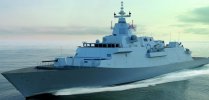Hi folks. Here is an update of weapons & systems the CSC Type 26 Frigate known so far:
1. 1 X LM Solid State 3D Active Electronically Scanned Array (AESA) "S" Band Long Range Discrimination Radar (LRDR)-SPY 7 (V) 1 Phased Array Air Search Radar-Confirmed by Lockheed Martin (LM).
2. 1 X Solid State AESA "X" Band Illumination Radar supported by MacDonald Dettwiller Associates (MDA) in Richmond British Columbia-below the SPY 7 radar mast, with integration into the CMS 330 system-this may be an MDA built radar or IMO it may be an existing radar from Thales (possibly the Sea Fire 500 AESA Phased Array Radar) however MDA is not talking. Any enlightenment on this radar from any forum members, would be appreciated.
3. "X" & "S" Bands Navigation Radars
4. MacDonald Dettwiller Associates (MDA)-Electronic Warfare Suite System & Chaff launchers
5. MacDonald Dettwiller Associates (MDA)-Laser Warfare Defence System (again MDA is not talking).
6. 32 x MK 41 strike length VLS-ESSM2, SM II/IIIC-SM3/6 (fitted for, but not with); Raytheon Tomahawk Land Attack Cruise Missiles (TLAM).
7. Combat Information Management Systems-Links 11/16/22/GCCS-M/ Mode 5S Identification Friend or Foe (IFF)
8. Light Weight (LW) MK 54 Torpedo system with twin launcher tubes
9. Sea Spider anti-torpedo system (Magellan/TKMS)
10. 6 x 4 ExLS VLS-Aft of the funnel (Sea Ceptor, quad-packed) for CIADS
11. 2 x 4 Quad packs Kongsberg NSM-Port/Stbd Above Mission Bay.
12. Main Gun: 1 x 5 inch Leonardo Oto Melara 127mm Light Weight (LW) Land Attack and Anti-Air Vulcano gun. This gun will confer the CSC ships with the ability to fire extended-range, precision-guided Vulcano munitions – both in guided long-range and the ballistic extended-range versions – and conventional ammunition.
13. Secondary Guns: 2 x 30mm DMS 30 (Bushmaster 30mm) Stabilized Rapid Fire 30mm Naval Gun Systems from BAE -(Port/Stbd of Flight Deck)
14. Cooperative Engagement Capability (CEC) Sensor Netting-Integrated Cyber Defence System; Integrated Bridge & Navigation System from OSI
15. Internal/External Communications Suite-HF/UHF/SHF/VHF/SATCOM from L3 Harris.
16. Electro Optical & Infrared Systems; Radio/Radar Electronic Support Measures (ESM) to include: Frequency Identification; Laser Warning & Countermeasures System; Radar/Radio Frequency Electronic Jammers; Electronic Decoy Systems.
17 CMS: Lockheed Martin CMS 330/Aegis Combat System (ACS) in support of Co-operative Engagement Capability (CEC).
18. Ultra Electronics Hull Mounted Sonar (HMS)-Ultra S2150.
19. Ultra Electronics Active/Passive Towed Array Sonar; Towed Torpedo Countermeasures-Sea Sentor S21700.
20. Sonobouy Processing System from General Dynamics with expendable Acoustic Countermeasures.
21. Combined Diesel Electric Gas Turbine (CODLOG) Propulsion System to include 1 X Rolls Royce RR/MT 30 Gas Turbine; 2 X Electronic Motors from General Electric; 4 X RR MTU Diesel Generators; Integrated Platform Management System from L3 Harris.
22. CH 148 Cyclone Sikorsky (S-92) ASW Helicopter; SKELDAR V200 UAV systems from Saab-known as CU-176 "Gargoyle"
23. Speed-approximately 27-30 kts. Statement Of Requirement (SOR) required this capability for US Carrier Battle Group (CBG) Ops.
24. Crew Compliment-204 max crew (fitted with separate female quarters)
If any member can add or subtract anything from this list, please let me know.



1. 1 X LM Solid State 3D Active Electronically Scanned Array (AESA) "S" Band Long Range Discrimination Radar (LRDR)-SPY 7 (V) 1 Phased Array Air Search Radar-Confirmed by Lockheed Martin (LM).
2. 1 X Solid State AESA "X" Band Illumination Radar supported by MacDonald Dettwiller Associates (MDA) in Richmond British Columbia-below the SPY 7 radar mast, with integration into the CMS 330 system-this may be an MDA built radar or IMO it may be an existing radar from Thales (possibly the Sea Fire 500 AESA Phased Array Radar) however MDA is not talking. Any enlightenment on this radar from any forum members, would be appreciated.
3. "X" & "S" Bands Navigation Radars
4. MacDonald Dettwiller Associates (MDA)-Electronic Warfare Suite System & Chaff launchers
5. MacDonald Dettwiller Associates (MDA)-Laser Warfare Defence System (again MDA is not talking).
6. 32 x MK 41 strike length VLS-ESSM2, SM II/IIIC-SM3/6 (fitted for, but not with); Raytheon Tomahawk Land Attack Cruise Missiles (TLAM).
7. Combat Information Management Systems-Links 11/16/22/GCCS-M/ Mode 5S Identification Friend or Foe (IFF)
8. Light Weight (LW) MK 54 Torpedo system with twin launcher tubes
9. Sea Spider anti-torpedo system (Magellan/TKMS)
10. 6 x 4 ExLS VLS-Aft of the funnel (Sea Ceptor, quad-packed) for CIADS
11. 2 x 4 Quad packs Kongsberg NSM-Port/Stbd Above Mission Bay.
12. Main Gun: 1 x 5 inch Leonardo Oto Melara 127mm Light Weight (LW) Land Attack and Anti-Air Vulcano gun. This gun will confer the CSC ships with the ability to fire extended-range, precision-guided Vulcano munitions – both in guided long-range and the ballistic extended-range versions – and conventional ammunition.
13. Secondary Guns: 2 x 30mm DMS 30 (Bushmaster 30mm) Stabilized Rapid Fire 30mm Naval Gun Systems from BAE -(Port/Stbd of Flight Deck)
14. Cooperative Engagement Capability (CEC) Sensor Netting-Integrated Cyber Defence System; Integrated Bridge & Navigation System from OSI
15. Internal/External Communications Suite-HF/UHF/SHF/VHF/SATCOM from L3 Harris.
16. Electro Optical & Infrared Systems; Radio/Radar Electronic Support Measures (ESM) to include: Frequency Identification; Laser Warning & Countermeasures System; Radar/Radio Frequency Electronic Jammers; Electronic Decoy Systems.
17 CMS: Lockheed Martin CMS 330/Aegis Combat System (ACS) in support of Co-operative Engagement Capability (CEC).
18. Ultra Electronics Hull Mounted Sonar (HMS)-Ultra S2150.
19. Ultra Electronics Active/Passive Towed Array Sonar; Towed Torpedo Countermeasures-Sea Sentor S21700.
20. Sonobouy Processing System from General Dynamics with expendable Acoustic Countermeasures.
21. Combined Diesel Electric Gas Turbine (CODLOG) Propulsion System to include 1 X Rolls Royce RR/MT 30 Gas Turbine; 2 X Electronic Motors from General Electric; 4 X RR MTU Diesel Generators; Integrated Platform Management System from L3 Harris.
22. CH 148 Cyclone Sikorsky (S-92) ASW Helicopter; SKELDAR V200 UAV systems from Saab-known as CU-176 "Gargoyle"
23. Speed-approximately 27-30 kts. Statement Of Requirement (SOR) required this capability for US Carrier Battle Group (CBG) Ops.
24. Crew Compliment-204 max crew (fitted with separate female quarters)
If any member can add or subtract anything from this list, please let me know.
Last edited:





